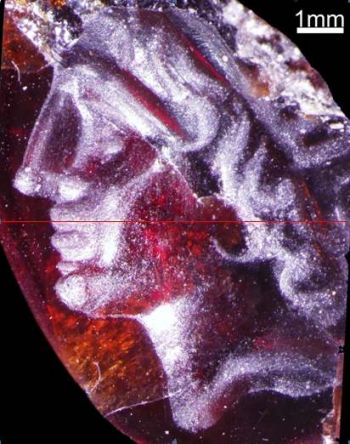The excavations were conducted by an archaeological expedition led by Dr. Ayelet Gilboa from the University of Haifa and Dr. Ilan Sharon from the Hebrew University.

A rare and surprising archaeological discovery in the Tel Dor excavations: a carved gem bearing the portrait of Alexander the Great was discovered in excavations conducted by an archaeological expedition led by Dr. Ayelet Gilboa from the University of Haifa and Dr. Ilan Sharon from the Hebrew University.
"Despite its tiny dimensions, the length of the gem (GEMMA) is less than a centimeter and its width is less than half a centimeter - the artist managed to shape the image of Alexander the Great in all its characteristics," said Dr. Gilboa, head of the Department of Archeology at the University of Haifa. "The king is described as an energetic young man, with a sharp chin and a straight nose, with long, curly hair held in a crown."
Tel Dor researchers point out that it is surprising that such a masterpiece was found precisely in the Land of Israel, which was on the fringes of the Hellenistic world. "It is accepted to assume that first-class artists - and the one who carved the figure of Alexander in this gem must have been one - worked mainly under the auspices of the courts of the great kings in Greece itself and in the main capitals - Alexandria in Egypt and Seleucia in Syria. It turns out that even local elites in secondary centers such as Dor could afford - and knew how to appreciate - elite art," the researchers emphasized.
The hole found in Dor is important because it was discovered inside a building of its time, in an orderly archaeological dig. The origin of most of the portraits of Alexander scattered in museums around the world is unknown. Some of them were already in various collections even before the beginning of scientific archeology, and some were bought on the black market. Do not rule out the possibility that some of them are even fake.
The cave was discovered during the excavation of a large public building from the Hellenistic period in the south of the mound. The motif engraved on it was identified by Dr. Jessica Nitschke - a professor of classical archeology at Georgetown University in Washington - as a protome of Alexander the Great. This identification was confirmed by Prof. A. Stewart from the University of California at Berkeley - an international expert who wrote a book about Alexander's portraits.
Alexander was probably the first Greek to invite artists to depict his image - as part of a cult of personality that became a propaganda tool used by kings and dictators ever since. The artists ingeniously combined lines of the ruler's true image with the classical beauty ideal of Greek art and with royal characteristics (in this case, the crown) and even deities from the world of images of Greek and ancient Near Eastern art. By doing this, Alexander probably wanted to give validity to his kingship in the eyes of all the subjects of the empire he conquered. These portraits were distributed throughout the kingdom on statues and mosaics placed in public places, as well as on small objects such as coins and seals. Alexander's portrait remained a popular motif even in the generations after his death - both as an independent motif and as an object of imitation. The figure of the young conqueror became a symbol of masculinity, heroism, and ideal kingship. Later Hellenistic rulers sought to appropriate these qualities by commissioning portraits of themselves in the likeness of Alexander. Dor was the main port city on the Sharon coast from the Middle Bronze Age (approximately 2000 BC) until the rise of Caesarea in the Roman period. Alexander the Great passed through it in 332 BC, after conquering Tire during his journey to Egypt. The city seems to have fallen into his hands without resistance. From then until the conquest by the Hasmonean Alexander the Great (approximately 100 BC) it was a stronghold of the foreign Greek population in the Land of Israel.
The archaeological expedition that has been excavating at Tel Dor for almost thirty years recently finished the 2009 excavation season. The excavation is shared by several academic institutions in Israel and abroad and is managed by Dr. Ayelet Gilboa from the University of Haifa and Dr. Ilan Sharon from the Hebrew University. The excavation is supported by the two institutions, the Society for the Study of AI and its Antiquities, the Berman Foundation for Biblical Archaeology, the Zinman Institute for Archaeology, the Wendy Goldhirsch Foundation in the USA and private donors. About 100 professionals, students and volunteers participated in this year's excavations. The Gemma is presented to the public at the Hazagga Museum in Kibbutz Nachsholim, at the foot of the hill.

4 תגובות
A plaited branch of cabbage? What do you mean by cabbage?
Scholars note that Alexander's curly hair was held by a crown.
This matter is not a trivial description: on the one hand, it is a crown that symbolizes the natural crown - a plaited branch of olive, laurel or cabbage, which used to adorn the heads of the Greek winners in the Pan-Hellenic competitions. On the other hand - the classical Greeks of the fifth century BC onwards were very wary of queen rulers, and Alexander behaved differently for various reasons - beyond being Macedonian and not Hellenic - mainly pragmatic (of lordship and control), when he adopted the customs that were accepted in the eastern basin of the Mediterranean Sea under the slogan of syncretism.
It is surprising, by the way, that Alexander's figure is almost never reflected in the coins and medallions of the Ancient Near East.
I think this is the image of the evil Antiochus
Impressive, very exciting.